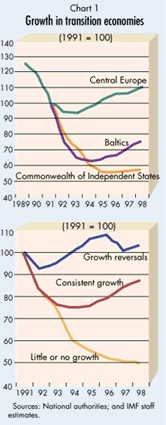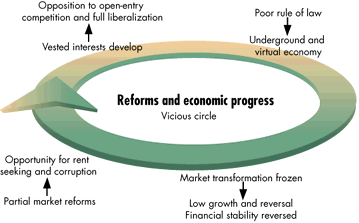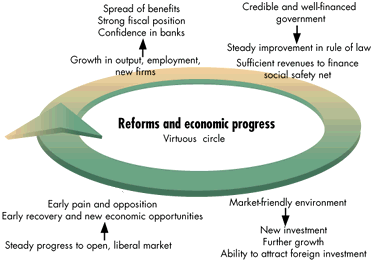|
Determinants of Growth in Transition Countries
Oleh Havrylyshyn and Thomas Wolf
Perhaps the most useful criterion for assessing success in the transition is the
sustainable recovery of output, which can be achieved only by controlling inflation and
liberalizing markets.
Transition is a dynamic historical process, imposing change on almost every element of
society. Assessing the progress of a great number of countries during transition is a
complex undertaking in any area, including economics. Success in recovering output,
however, readily suggests itself as a useful unifying theme for economic assessment, not
least because of the importance policymakers in transition economies attach to output
growth and its immediacy for the welfare of everyone in those countries. Based on
extensive econometric analysis, this article identifies factors that have inhibited or
encouraged the expansion of output and points out several lessons for achieving consistent
and sustainable economic growth.
What does transition mean?
In a broad sense, transition implies
- liberalizing economic activity, prices, and market operations, along with reallocating
resources to their most efficient use;
- developing indirect, market-oriented instruments for macroeconomic stabilization;
- achieving effective enterprise management and economic efficiency, usually through
privatization;
- imposing hard budget constraints, which provides incentives to improve efficiency; and
- establishing an institutional and legal framework to secure property rights, the rule of
law, and transparent market-entry regulations.
Factors behind growth
 No one pattern characterizes the growth experience of the
transition economies. Indeed, substantial differences exist among the countries of Central
Europe, the Baltics, and the 12 members of the Commonwealth of Independent States (CIS),
although the Baltics share some characteristics with the other two groups, specifically,
the deep decline of the CIS and the earlier recovery of Central Europe. It is useful,
however, to view the 25 transition countries as falling into several categories: those
with consistent growth, those with growth reversals, and those with little or no growth
(Charts 1 and 2). No one pattern characterizes the growth experience of the
transition economies. Indeed, substantial differences exist among the countries of Central
Europe, the Baltics, and the 12 members of the Commonwealth of Independent States (CIS),
although the Baltics share some characteristics with the other two groups, specifically,
the deep decline of the CIS and the earlier recovery of Central Europe. It is useful,
however, to view the 25 transition countries as falling into several categories: those
with consistent growth, those with growth reversals, and those with little or no growth
(Charts 1 and 2).
Do the transition economies differ all that much from one another? What elements in
their structure and development shed light on their differing rates of growth? Regression
analysis done in an underlying study allows us to draw a number of conclusions.
- The three groups differ considerably from one another in growth rates, with the Central
European and the Baltic countries showing a solid, steady rate of over 4 percent a year,
while CIS countries as a whole, and those countries that have undergone economic
reversals, give evidence of much less progress. These uneven growth rates suggest that
differences in initial conditions, such as having less distorted economic structures or
closer similarities to market economies, may be important determinants of subsequent
progress. But while initial conditions do matter—as the contrast in performance
between Central Europe and the CIS shows—they are less relevant for growth than are
differences in policy during the transition. Growth rates in the group of CIS countries
that show progress are very high, because several small economies (Armenia, Azerbaijan,
and Georgia) that initially suffered economic decline in the wake of conflict and civil
unrest are rebounding from very low bases.
 Growth has generally been more vigorous and has certainly
come sooner in countries that have controlled inflation. Countries with consistent growth
have, on average, much lower inflation rates. Growth has generally been more vigorous and has certainly
come sooner in countries that have controlled inflation. Countries with consistent growth
have, on average, much lower inflation rates.
Another key determinant of progress is the degree of reform or market liberalization.
An analysis of the liberalization of prices, the financial sector, and external trade, and
of enterprise reform indicates a distinctly higher liberalization index in the Baltics and
Central Europe—that is, in the countries with much better growth
performance—than in countries that have suffered growth reversals or have experienced
slower growth.
Countries that liberalized prices early and comprehensively have experienced the
earliest output recoveries. Output has also increased rapidly in countries with high
average growth rates of exports, suggesting that opening an economy to outside influences
and stimulating output to generate exports are important determinants of growth.
The share of the private sector in GDP is distinctly larger for countries with rapid
and consistent growth than for those with slow and uneven growth. As always, exceptions to
the rule can be found. Russia, for example, has made great strides in privatization but
exhibits little or no growth. The shortcomings of its approach to privatization are
perhaps one reason why growth did not follow. (See the article by John Nellis in this
issue.)
Foreign direct investment appears to play a role. This investment is highest in the
successful economies of Central Europe and the Baltics, where it amounts to $70–$75
per capita. That the causation does not run from growth to foreign investment is suggested
by the fact that even those CIS countries that have enjoyed consistent growth have not
attracted anything like the same amounts of foreign direct investment.
A significant score on an index of effective implementation of IMF programs appears to
be strongly correlated with growth performance. This finding should not be interpreted as
suggesting that good performance on IMF programs is all it takes to achieve growth.
Rather, countries that do well under IMF programs also have made the commitment to do well
in promoting general economic reform and stabilization, creating an environment conducive
to vigorous economic growth.
Further observations on growth
First, the period of transition can usefully be divided into the early so-called
decline period (1990–93) and the later growth period (1994–98). The statistical
fit for most variables is far stronger for the growth period than for the period of
decline.
Second, the influence on output of many key variables—the reform index (based on
World Bank and European Bank for Reconstruction and Development (EBRD) work), for
instance—is again far stronger in the growth period than in the first period.
Third, those who suggest that reform is painful are absolutely right. Output declines,
and does so more sharply in fast reformers, but early reforms pay off in terms of earlier
recovery and more robust subsequent growth (Poland is a case in point). The regression
results noted above confirm this payoff. In the first (decline) period, the relationship
between growth and reform traces a U-shaped curve: the growth rate is higher (or the rate
of decline lower) in countries with strong reform programs as well as in those with very
limited reform programs. In the second (recovery) period, the relationship is uniformly
positive: growth is slowest in the least advanced reformers, somewhat faster in those that
are moderately advanced, and fastest in the most advanced reformers.
Fourth, investment alone does not ensure early growth and recovery—that is, one
cannot force economic growth by increasing investment. Given that investment takes time to
produce output, it is normal to see investment increases followed by growth increases two
or three years later. One does not observe this pattern in transition economies, where
investment-to-GDP ratios generally started rising only when growth began to recover. The
explanation is that early growth is due to the efficiency gains resulting from appropriate
reforms—that is, hard budget constraints and liberalization—that generate
incentives for entrepreneurs to become more productive. This does not, however, mean that
investment is unimportant. Some new investment, localized at the firm level or in a given
sector, will be needed for initial growth. Furthermore, once recovery is well under
way—as, for example, in Hungary or Poland—a higher level of investment becomes
increasingly important if growth is to be sustained. But until conditions for an
efficiency-seeking market economy are in place, investment alone is not going to provide
sustainable growth.
Lessons
We conclude by noting five lessons for countries seeking to achieve consistent and
sustainable growth.
- The first is the least surprising and least controversial: sustained macroeconomic
stabilization (that is, inflation control) is essential.
- The second lesson is "no pain, no gain." Delayed reforms can indeed defer the
pain, but they also defer sustained recovery and increase the risk that growth will be
reversed. At first glance, there appear to be certain exceptions. Belarus and Uzbekistan,
for instance, have grown in recent years, yet their reform efforts, as measured by the
index, were not strong. These countries exhibit some of the same characteristics as
Albania, Bulgaria, and Romania (high inflation during growth, limited advances in reform)
and may suffer reversals as those three countries did, but this remains to be seen.
- The third lesson is that there is no royal road to reform. In our analysis, we attempted
to test whether any one of the individual components of reform by itself pointed the way.
The answer was no. Basically, all the components show an individually positive correlation
with growth, but when the overall index is examined, none has an overpowering impact.
Thus, there is no one key, no panacea. One needs to implement all the different components
of reform. Growth comes as a result of a great deal of effort by many people doing the
right things over an extended period.
- The fourth lesson concerns unfavorable initial conditions. It is fair to ask whether
relatively favorable initial conditions in Central Europe provided those countries with an
opportunity to recover more quickly than the countries of the former Soviet Union. The
answer, of course, is yes. Conversely, unfavorable initial conditions, such as a distorted
industrial system, certainly have a negative effect on growth. However, that negative
effect is by no means fatal and can be offset by comprehensive reforms. The best
illustration of this may be the Baltic countries, which have achieved growth performances
comparable to those of the most advanced reformers among the Central European countries.
They had the same unfavorable initial condition of overindustrialization as most of the
countries of the former Soviet Union and started far behind Central Europe. But, much more
quickly than the CIS countries, the Baltic countries undertook reforms, achieved greater
liberalization, and then achieved substantial rates of growth.
- The fifth lesson concerns institutional development. The econometric analysis included a
separate index for the development of a legal framework, which appears to play an
important role in reform. The results suggest that developing an appropriate legal
structure is indispensable, but not necessarily in advance of other reforms. However, if
development of the legal system is delayed too long—if one puts off the
implementation of the rule of law, enforcement of discipline, and security of property
rights—then other reforms are unlikely to produce significant benefits.
What about the political economy?
Let us finish by relating this analysis to the political economy aspects of transition.
It is all too easy for a country to find itself in a vicious circle in which initial steps
toward market reform create opportunities for rent seeking and corruption. Vested
interests that benefit from these opportunities very soon establish themselves and resist
further reform steps, such as allowing open entry to the market, fostering competition,
providing for full liberalization, and establishing a solid rule of law. As a side effect,
an underground economy emerges. Limited competition, incomplete liberalization, incentives
to go underground, and the uneven rule of law can freeze the transformation in its tracks.
Slow economic progress, a reversal of growth, and a collapse of financial stabilization
can easily result.
Countries' reform efforts can have a happier ending if they create a virtuous circle,
allowing them to make steady progress toward an open, liberal market. Although there will
be early pain, and political opposition because of the pain, there will also be earlier
recovery and new economic opportunities. These opportunities can encourage output growth,
and new firms and jobs will be created as the benefits of reform begin to spread. A
stronger economy improves a country's fiscal position and engenders confidence in
financial institutions. These conditions provide the basis for a credible and
well-financed government, which, in turn, is able to impose the discipline of law, secure
property rights, and provide an adequate social safety net. This market-friendly
environment encourages saving, new investment, and further growth, thus completing the
virtuous circle.
The contrast between the vicious and virtuous circles is stark (see boxes). The
decisive factor that permits a country to move from the vicious to the virtuous circle is,
in our view, the political will to impose the rule of law and establish the security of
property rights.


| Oleh Havrylyshyn, a former deputy
finance minister of Ukraine, is Senior Advisor in the IMF's European II Department.
Thomas Wolf is Assistant Director in the IMF's European II Department. |
|